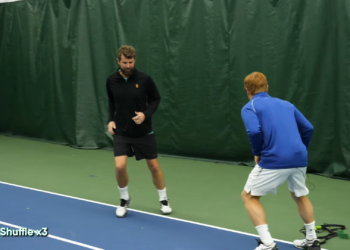If you’re like most tennis players I meet, whether on the court, in our workshops, or deep in the comments on one of our PlayYourCourt videos, there’s one question that always comes up:
“Am I using the right grip for my forehand?”
The challenge? Most players choose a grip by accident.
You pick up a racquet, find what feels “natural,” and never think twice, until you hit that frustrating wall.
That’s where understanding the Eastern vs Western grip debate really matters.
This is about:
- How high the ball bounces on your court.
- How much spin you want to generate.
- Whether you’re a baseliner grinding it out or a doubles specialist crashing the net.
- And ultimately, how fast you want to improve.
In this guide, we’re going deep into the differences between Eastern and Western forehand grips, what they feel like, how they perform, and who they’re really for.
And if you’re already feeling overwhelmed? Don’t worry. My team and I built PlayYourCourt to help players like you cut through the noise.
Whether you’re a complete beginner or a lifelong competitor stuck on a plateau, we’ll help you figure out which grip gives you the best chance to hit harder, play longer, and win more.
Let’s find your fit.
Forehand Grips in Tennis Explained (With Bevel Guide)
What Is a Forehand Grip?
Your forehand grip is the way your hand connects with the racquet handle when you hit a forehand and it determines almost everything about how that shot performs.
Grip dictates your swing path, the angle of your racquet face, how much topspin you can generate, and how much control you have over placement and power.
But here’s what most coaches miss: the “right” grip is about what works for your body, your court, and your goals.
That’s why understanding grip structure, how grips are formed, is critical.
Learning Bevels: How Grips Are Formed
The base of your racquet is shaped like an octagon.
These eight sides are called bevels, and the location of your index knuckle and the heel pad of your palm on these bevels is what defines your grip.
Each grip corresponds to a specific bevel:
- Bevel 2: Continental (mainly for serves, volleys)
- Bevel 3: Eastern
- Bevel 4: Semi-Western
- Bevel 5: Western
Even tiny adjustments (like sliding half a bevel over) can significantly change how your racquet interacts with the ball.
📌 Pro Tip: Grab a Sharpie and label your racquet’s bevels when learning new grips. It’s a small trick that makes a huge difference in consistency and confidence.
The Eastern Grip: Hand Placement on Bevel 3
The Eastern forehand grip is your go-to for flatter, more penetrating shots. To find it, place the base knuckle of your index finger and the heel of your hand on bevel 3.
This grip feels like a natural handshake with your racquet.
It’s clean, efficient, and gives you great control, especially for low balls and fast surfaces like hard courts or grass.
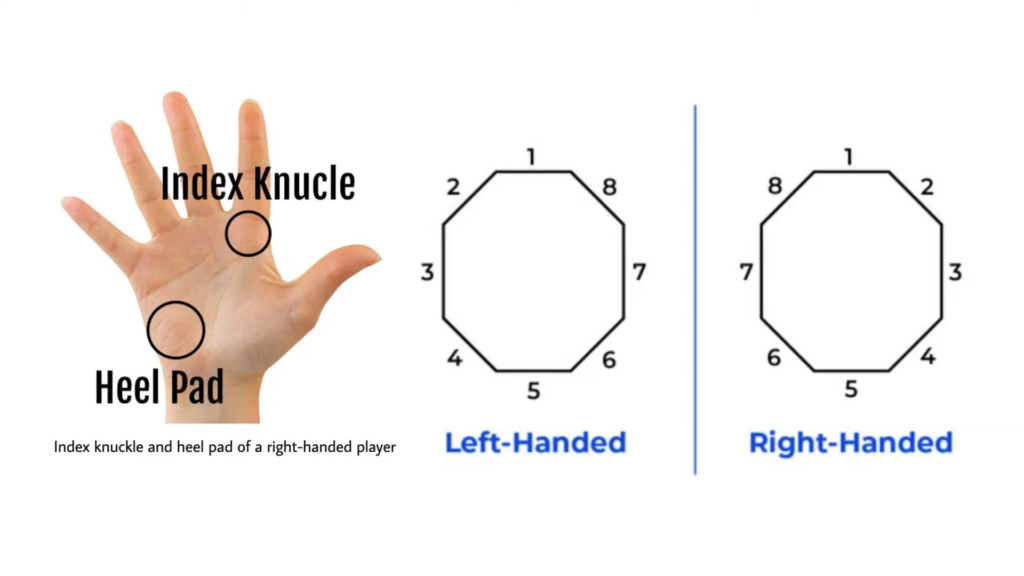
Most beginners gravitate toward this grip without even realizing it, which makes sense: it’s intuitive and easy to learn. But that simplicity has limits.
While the Eastern grip excels at flattening out balls, it doesn’t generate much topspin unless you pair it with advanced swing techniques (like the windshield wiper finish).
Still, some of the best to ever play the game, Federer included, used an Eastern or slightly modified version of it. And for serve-and-volley players, doubles specialists, or anyone looking for a versatile all-court weapon, this grip is a strong choice.
The Western Grip: Hand Placement on Bevel 5
Now let’s swing the pendulum.
The Western grip, with the base knuckle and heel pad on bevel 5, is all about spin.
We’re talking big, looping, aggressive topspin that kicks the ball up high and deep. This is the grip of choice for clay-court grinders, heavy rally hitters, and players looking to dominate from the baseline.
The trade-off? It’s not beginner-friendly.
The Western grip can feel awkward at first, almost like you’re turning your racquet into a frying pan. It requires strong wrists, impeccable timing, and solid lower body movement to hit consistently, especially on low balls or fast courts.
That said, if you’re playing on high-bounce surfaces or struggling to keep your shots inside the baseline, Western can give you the spin you need to create margin and stay aggressive.
Just be cautious. recreational players often overuse this grip and end up reinforcing bad habits or, worse, dealing with wrist pain from improper technique.
The Semi-Western Middle Ground (Bonus Context)
If Eastern is too flat and Western is too extreme, meet your new best friend: the Semi-Western grip.
With your knuckle and heel on bevel 4, this grip blends the best of both worlds, solid topspin with enough versatility to flatten out when needed. That’s why it’s the most common grip on the pro tour today.
We often teach Semi-Western first, especially for juniors and developing players. It allows for a more modern forehand shape and fits well with today’s topspin-heavy game.
You’ll see it in the hands of Tsitsipas, Serena, and countless others.
For most players who want to improve fast without reinventing their swing, Semi-Western is the sweet spot.
And if you’re switching from Eastern to Western or vice versa, Semi-Western makes a great transitional grip to experiment with.
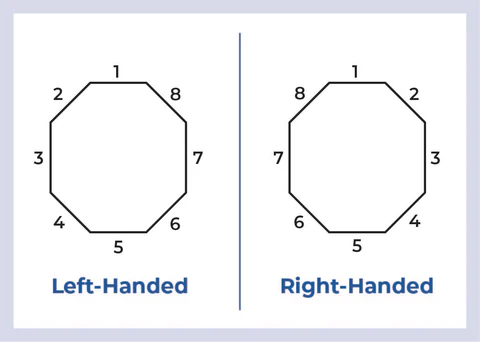
Source -> https://tennisbuilder.com/pages/grip-overview
Eastern vs Western Grip: The Core Differences
Once you understand how grips are formed, the real question becomes: What actually changes when you use one grip over another?
A lot.
Your grip affects the shape of your shot, the height of your contact point, how well you recover between shots, and even how long you can rally before your wrist or shoulder starts screaming.
Topspin Generation: Western Wins on RPMs
If you’re chasing topspin, the Western grip is your rocket launcher.
With your hand wrapped around bevel 5, the racquet face naturally closes, meaning the strings face slightly down at contact.
This forces you to swing up and through the ball, creating that vicious low-to-high path that produces massive RPMs.
Rafael Nadal is the poster child here.
His Western-ish grip helps generate over 3,200 RPMs on forehands, giving his shots insane bounce and arc that push opponents back behind the baseline.
In contrast, the Eastern grip on bevel 3 promotes a flatter trajectory.
The racquet face is more vertical, which limits how much spin you can apply unless you deliberately add extra wrist lag and follow-through (like the windshield wiper finish).
So if your goal is to kick the ball up off the court and wear your opponent down with high-bouncing spin? Western is your go-to.
Just know, it comes at a price (more on that in a second).
Power & Penetration: Eastern Hits Flatter, Harder
Want clean, powerful drives that feel like a laser off your strings? That’s where the Eastern grip shines.
Because of its more neutral racquet face, this grip allows for a more direct swing path through the ball.
The result? Flatter, faster shots that knife through the court, especially on low balls or faster surfaces like hard court and grass.
It’s no surprise that Roger Federer, one of the cleanest strikers in history, plays with an Eastern-to-Semi-Western hybrid. His forehand might not have Nadal’s RPMs, but it penetrates the court like a missile.
Western, by contrast, adds more topspin, but sacrifices that flat, “through the court” power.
Western forehands tend to loopy, not laser-like. That’s great for consistency, not always for finishing points.
So if you’re a player who likes dictating with depth and pace, Eastern might give you the edge.
Contact Point & Court Positioning
Your grip determines where you should make contact with the ball and that changes how you move and position yourself.
- Eastern Grip: Optimal contact is waist high and slightly out front. This works well for lower-bouncing balls and keeps your positioning more compact.
- Western Grip: Best contact is shoulder height or higher, which means you’ll naturally play further behind the baseline to allow the ball to rise.
This is why Western grips thrive on high-bouncing clay courts, while Eastern grips feel more comfortable on grass or synthetic hard courts.
Here’s where players get stuck: if you switch to a Western grip but keep positioning like an Eastern user, you’ll mistime everything.
It’s about your feet and court positioning too. That’s why we say: “Grip changes are footwork changes in disguise.”
Physical Demand & Risk of Injury
One of the biggest red flags I see from recreational players: adopting a Western grip because “pros use it,” only to end up with sore wrists, tight forearms, or nagging shoulder pain.
Why?
The Western grip requires extreme wrist flexion and forearm rotation.
That’s fine if you’re 19, have pro-level fitness, and train six hours a day. But for the rest of us, especially older players or anyone with mobility issues, it’s a recipe for breakdown.
If your wrist hurts after extended rallies using a Western grip, that’s your body waving a red flag.
PlayYourCourt often discourages full Western adoption unless you’ve built the strength and mechanics to support it.
Eastern is more wrist-neutral. It’s easier on your joints, more sustainable for most players, and allows for better grip transitions during quick exchanges.
Transition to Net Play: Which Is Easier?
If you’re a singles all-court player or love doubles, here’s something to seriously consider: grip transitions.
- With an Eastern grip, you can quickly shift to a Continental grip for volleys or serves without major adjustment. It’s seamless and fluid, which makes it ideal for net rushers or serve-and-volley players.
- With a Western grip, switching to volleys is a chore. You have to rotate your hand across multiple bevels, and if you don’t time it perfectly? You’ll volley like you’re holding a frying pan.
This is why Western grips are rare in pro doubles and why many recreational players using a Western grip struggle at the net.
If you’re serious about becoming a complete player with both baseline and net skills, Eastern or Semi-Western will serve you better in the long run.
🔍 Quick Fact:
Federer uses an Eastern grip, Nadal leans heavily Western. Both are legends. Your grip doesn’t define your ceiling, but it does define the road you’ll take to get there.
Pros & Cons of Each Grip (With Player Examples)
Choosing a forehand grip is about trade-offs.
Each grip offers specific strengths, but it also comes with limitations that can creep into your game if you’re not aware of them.
Here’s how Eastern and Western grips stack up in real-world scenarios.
Eastern Grip: Benefits & Limitations
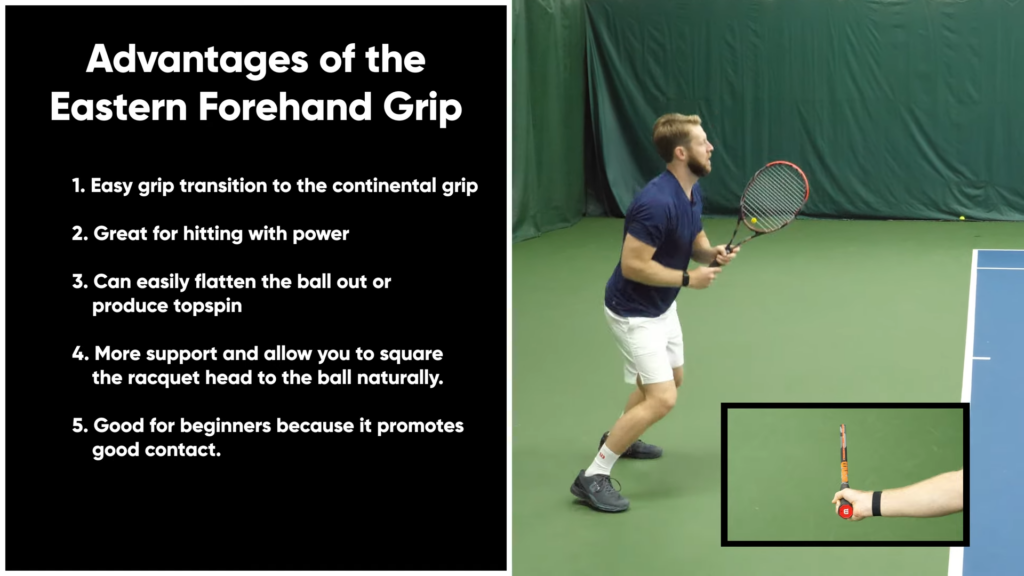
✅ Benefits:
- Great for all-court play. The Eastern grip offers unmatched versatility. Whether you’re rallying from the baseline, charging the net, or playing serve-and-volley tennis, this grip makes it easier to adjust on the fly.
- Perfect for doubles. Because it transitions quickly to the Continental grip, the Eastern grip is ideal for fast hands at the net and crisp, punchy volleys. You can move fluidly from groundstrokes to net play without fumbling grip switches.
- Low ball performance. If you often play on grass or fast hard courts, the Eastern grip thrives in those low-bouncing environments. It keeps the racquet face more vertical, helping you drive through balls that stay under your knees.
- Less strain on the wrist. This grip keeps your wrist in a more neutral, ergonomic position, great for older players or those with past injuries.
❌ Limitations:
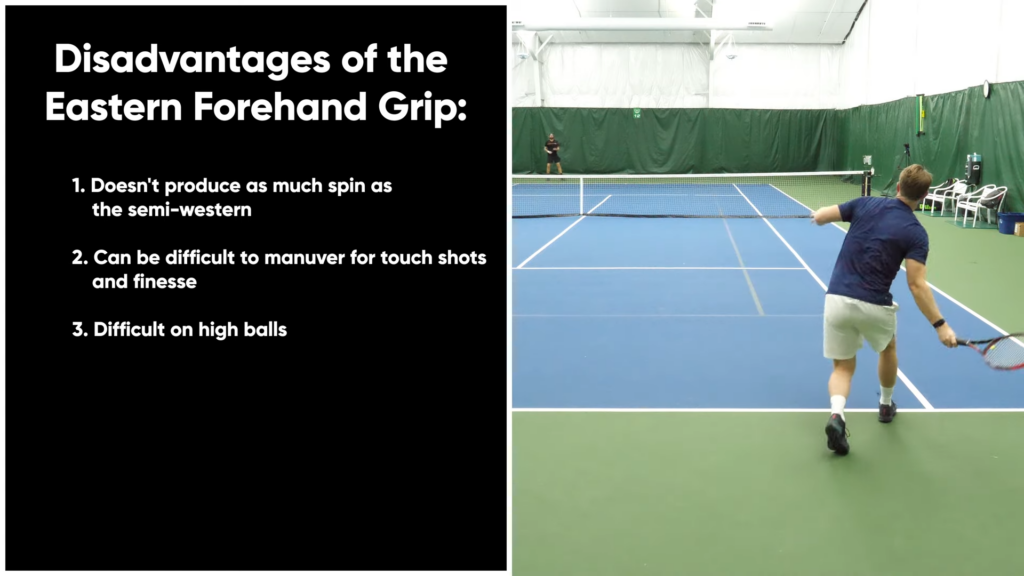
- Struggles with high balls. When the ball jumps up above shoulder height, especially on clay or in humid conditions, the Eastern grip starts to show its limits. You’ll often hit late or flat without much topspin to bring the ball down.
- Less topspin generation. While not impossible, generating heavy RPMs with an Eastern grip requires more advanced techniques like the windshield wiper forehand or exaggerated low-to-high swing paths.
Still, if you’re a developing player who values control, comfort, and flexibility, Eastern gives you a strong foundation that grows with your game.
Western Grip: Benefits & Limitations
✅ Benefits:
- Topspin machine. The Western grip is built for spin. Its closed racquet face naturally forces a vertical swing path, creating massive topspin that keeps shots deep and safe even when you swing full throttle.
- Great for baseline grinders. If you live on the baseline, love long rallies, and enjoy punishing your opponent with heavy balls that push them back, this grip gives you the tools to build that game.
- Ideal for clay courts. The higher bounce on clay plays right into the Western grip’s strengths. It lets you hit aggressive shots shoulder-high while staying on balance.
❌ Limitations:
- Tough on the wrist and arm. The extreme positioning required to swing effectively with a Western grip adds strain to your wrist, forearm, and even shoulder. If you’re not conditioned for it, pain and injury can sneak in fast.
- Low balls become a nightmare. With this grip, low contact points feel like trying to hit a fastball with a spoon. You either scoop under it and moonball or mistime completely.
- Grip transitions are clunky. Moving from a Western forehand to a Continental grip for volleys or slices takes longer and can cost you precious milliseconds during a point, especially in doubles or fast rallies.
Pro Players Who Use Each Grip
Let’s look at how some of the best in the world weaponize these grips:
- Roger Federer: Plays with an Eastern-to-Semi-Western hybrid. His flatter forehand allows him to redirect pace and play surgical offense, particularly on faster courts.
- Rafael Nadal: The king of topspin. His Western grip allows for looping forehands that jump off the court, deadly on clay and exhausting for opponents.
- Stefanos Tsitsipas: Semi-Western forehand with excellent balance between spin and drive. Ideal for all surfaces and modern baseline exchanges.
- Serena Williams: Uses a hybrid between Eastern and Semi-Western. She generates heavy pace with control and can flatten or spin based on situation.
The takeaway? There’s no single “right” grip. The pros have found grips that match their game style, physique, and surface preference. Your job is to do the same.
Grip Choice by Player Type: Which One Should You Use?
No two tennis players are built the same and neither should their grips be.
Your playing style, skill level, physical ability, and goals all influence what grip works best for you. So instead of asking, “What’s the best grip?” a better question is, “What’s the best grip for me, right now?”
Here’s how to think about it based on where you are in your tennis journey.
Beginners: Why Eastern Is Easier to Start With
If you’re just picking up the game or you’ve hit a few times and want to get serious, the Eastern grip is your best friend.
Why? Because it’s:
- Intuitive (feels like a handshake with your racquet)
- Easier to use on low balls and flat shots
- Perfect for learning clean contact and swing path mechanics
The Eastern grip gives beginners a stable foundation to build good timing, spacing, and power without having to “muscle” the ball.
Pro tip: Want more spin later? Learn a windshield wiper finish first, then layer in more aggressive grip changes when you’re ready.
Intermediate Players: Should You Switch to Western?
If you’re an intermediate playe you might feel like you’ve hit a wall. Your shots are solid, but you’re not generating enough topspin. You’re hitting long. You’re getting punished by high balls.
So… should you switch grips?
Maybe. But maybe not.
The Western grip can unlock more spin, but it comes with trade-offs:
- Harder timing on low balls
- Slower grip transitions
- Risk of wrist strain if not paired with proper footwork and recovery
Many players are actually using a flawed Semi-Western without realizing it, so the fix might be more about movement and swing mechanics than a total grip overhaul.
🧠 Coaching Insight: If changing your grip means you’ll have to “rebuild your game from scratch,” it’s probably not worth it. Instead, try hybrid drills that slowly introduce Western mechanics within your existing grip comfort zone.
Baseliners vs Net Rusher: Grip Match by Style
Your tactical identity plays a huge role in grip choice.
- If you’re a baseliner who lives for heavy rally exchanges, the Semi-Western or Western grip gives you more margin, bounce, and depth.
Especially if you like hitting with shape and spin from deep behind the baseline.
- If you’re an all-court player who likes to approach and finish at net, or if you’re a doubles specialist, the Eastern grip is your MVP.
It transitions quickly to the Continental grip and lets you volley, slice, and approach with minimal adjustment.
- If you’re a hybrid player, someone who likes to attack off both wings but also ventures to net, go with Semi-Western.
It blends spin with transitional ease and gives you options on every shot.
Besides that it’s a technique decision, it’s a tactical one too.
What you gain in spin with Western, you may lose in versatility. Choose the grip that matches your strategy, not someone else’s highlight reel.
How to Find Your Ideal Grip (Without Guesswork)
There’s no one-size-fits-all grip. What works for Federer won’t necessarily work for you, and copying your hitting partner’s style might just dig your game into a deeper rut.
Finding your ideal grip requires self-awareness, testing, and a little science.
Here’s how to stop guessing and start finding the grip that gives you the best results.
Grip Self-Test: Shadow Swings at Different Heights
One of the simplest ways to test grip comfort is with shadow swings, no ball, no opponent, no pressure. Start swinging forehands at different heights: knee level, waist level, and shoulder level.
Ask yourself:
- Which height feels most natural?
- Do certain contact points cause wrist tension or timing issues?
- Can you maintain racquet face control through the full swing?
For example, if your swing breaks down at shoulder height with an Eastern grip, that’s your body telling you it might not be the best fit for high-bouncing surfaces or topspin-heavy rallies.
This drill is a great way to spot hidden weaknesses before they show up in match play.
Try the “Forehand Journal” Method
We often ask players to start a grip journal, a simple, low-tech but powerful tool to uncover patterns in performance.
After each practice session or match, jot down:
- Which grip you used
- How your forehand felt (spin, power, control)
- Whether your wrist or arm felt tight
- How consistent your timing was
Over time, this journal becomes a roadmap.
You’ll start to see trends, like how your Semi-Western grip works better on slower courts, or how your wrist aches after long sessions with a full Western.
PlayYourCourt’s coaching team swears by this. Our top students use it to track their grip evolution and avoid reverting to bad habits under pressure.
Use Video Analysis to Track Grip Performance
What we think we’re doing and what we’re actually doing are rarely the same, especially when it comes to grip use.
Record a few rallies or hitting sessions and watch in slow motion. Look for:
- Grip shifting mid-rally
- Inconsistent contact points
- Wrist positioning under stress
You may be shocked to discover you’re using a hybrid grip you weren’t even aware of or that your hand slips on the racquet as you fatigue.
Video doesn’t lie. It’s one of the fastest ways to identify subtle grip breakdowns that sabotage your shots without you knowing it.
Seek Feedback During Rally, Not Just Drills
Static drills are useful, but they won’t tell you what’s happening mid-rally. Your grip might feel great during hand-fed balls, but everything can change once you’re on the move, reacting to pace, or under pressure.
That’s why we ask PlayYourCourt coaches and partners to observe real rallies and provide feedback:
- Does your grip hold up under pressure?
- Do you switch grips unintentionally?
- Are you defaulting to something easier when rushed?
The feedback you get during match-like situations is far more valuable than anything in a controlled setting.
Don’t Rush the Switch, Layer It Over Time
Switching your grip is not like flipping a switch, it’s like updating your swing software. You need to debug, test, and recondition muscle memory gradually.
Start by introducing your new grip during warm-up or mini tennis. Then use it in drills. Finally, test it during low-pressure rallies.
Don’t feel like you have to convert 100% overnight.
Remember: consistency is the goal, not just change. Your new grip should feel reliable, not forced.
🧪 Unique Drill:
In our PlayYourCourt live workshops, we run hybrid grip drills that rotate players through Eastern, Semi-Western, and Western grips mid-rally.
The goal? Build adaptive muscle memory so you can choose the right grip at the right time without overthinking it. These drills reveal what feels best, not just what you’ve always used.
Which Grip Is Better for YOU?
If there’s one thing I’ve learned as a coach and as the guy behind PlayYourCourt, it’s this: there is no one perfect grip.
There’s only the grip that works best for you, your body, your style, your goals.
The most important takeaway? Your grip is a tool.
And tools can be refined, swapped, and adapted over time. The biggest mistake is sticking with one that no longer serves your game.
Not sure if your grip is helping or hurting your game? 👉 Try PlayYourCourt’s 7-Day Game Improvement Challenge Free.
You’ll get personalized feedback on your forehand from a real coach, plus targeted drills to unlock more spin, control, and power right away.
Your next level starts with the right grip. Let’s find it together.


